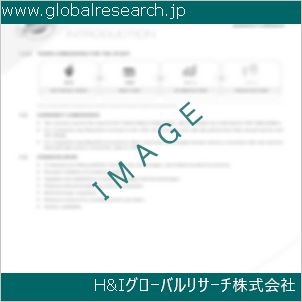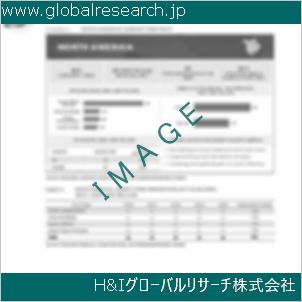Table of Contents
1 Industry Overview of Sodiumarsenate
1.1 Definition and Specifications of Sodiumarsenate
1.1.1 Definition of Sodiumarsenate
1.1.2 Specifications of Sodiumarsenate
1.2 Classification of Sodiumarsenate
1.3 Applications of Sodiumarsenate
1.3.1 Nuclear Application
1.3.2 Non-Nuclear Application
1.4 Industry Chain Structure of Sodiumarsenate
1.5 Industry Overview and Major Regions Status of Sodiumarsenate
1.5.1 Industry Overview of Sodiumarsenate
1.5.2 Global Major Regions Status of Sodiumarsenate
1.6 Industry Policy Analysis of Sodiumarsenate
1.7 Industry News Analysis of Sodiumarsenate
2 Manufacturing Cost Structure Analysis of Sodiumarsenate
2.1 Raw Material Suppliers and Price Analysis of Sodiumarsenate
2.2 Equipment Suppliers and Price Analysis of Sodiumarsenate
2.3 Labor Cost Analysis of Sodiumarsenate
2.4 Other Costs Analysis of Sodiumarsenate
2.5 Manufacturing Cost Structure Analysis of Sodiumarsenate
2.6 Manufacturing Process Analysis of Sodiumarsenate
3 Technical Data and Manufacturing Plants Analysis of Sodiumarsenate
3.1 Capacity and Commercial Production Date of Global Sodiumarsenate Major Manufacturers in 2023
3.2 Manufacturing Plants Distribution of Global Sodiumarsenate Major Manufacturers in 2023
3.3 R&D Status and Technology Source of Global Sodiumarsenate Major Manufacturers in 2023
3.4 Raw Materials Sources Analysis of Global Sodiumarsenate Major Manufacturers in 2023
4 Capacity, Production and Revenue Analysis of Sodiumarsenate by Regions, Types and Manufacturers
4.1 Global Capacity, Production and Revenue of Sodiumarsenate by Regions 2019-2024
4.2 Global and Major Regions Capacity, Production, Revenue and Growth Rate of Sodiumarsenate 2019-2024
4.3 Global Capacity, Production and Revenue of Sodiumarsenate by Types 2019-2024
4.4 Global Capacity, Production and Revenue of Sodiumarsenate by Manufacturers 2019-2024
5 Price, Cost, Gross and Gross Margin Analysis of Sodiumarsenate by Regions, Types and Manufacturers
5.1 Price, Cost, Gross and Gross Margin Analysis of Sodiumarsenate by Regions 2019-2024
5.2 Price, Cost, Gross and Gross Margin Analysis of Sodiumarsenate by Types 2019-2024
5.3 Price, Cost, Gross and Gross Margin Analysis of Sodiumarsenate by Manufacturers 2019-2024
6 Consumption Volume, Consumption Value and Sale Price Analysis of Sodiumarsenate by Regions, Types and Applications
6.1 Global Consumption Volume and Consumption Value of Sodiumarsenate by Regions 2019-2024
6.2 Global and Major Regions Consumption Volume, Consumption Value and Growth Rate of Sodiumarsenate 2019-2024
6.3 Global Consumption Volume and Consumption Value of Sodiumarsenate by Types 2019-2024
6.4 Global Consumption Volume and Consumption Value of Sodiumarsenate by Applications 2019-2024
6.5 Sale Price of Sodiumarsenate by Regions 2019-2024
6.6 Sale Price of Sodiumarsenate by Types 2019-2024
6.7 Sale Price of Sodiumarsenate by Applications 2019-2024
6.8 Market Share Analysis of Sodiumarsenate by Different Sale Price Levels
7 Supply, Import, Export and Consumption Analysis of Sodiumarsenate
7.1 Supply, Consumption and Gap of Sodiumarsenate 2019-2024
7.2 Global Capacity, Production, Price, Cost, Revenue, Supply, Import, Export and Consumption of Sodiumarsenate 2019-2024
7.3 USA Capacity, Production, Price, Cost, Revenue, Supply, Import, Export and Consumption of Sodiumarsenate 2019-2024
7.4 EU Capacity, Production, Price, Cost, Revenue, Supply, Import, Export and Consumption of Sodiumarsenate 2019-2024
7.5 China Capacity, Production, Price, Cost, Revenue, Supply, Import, Export and Consumption of Sodiumarsenate 2019-2024
7.6 Japan Capacity, Production, Price, Cost, Revenue, Supply, Import, Export and Consumption of Sodiumarsenate 2019-2024
8 Major Manufacturers Analysis of Sodiumarsenate
8.1 Manufacturer One
8.1.1 Company Profile
8.1.2 Product Picture and Specifications
8.1.2.1 Type I
8.1.2.2 Type II
8.1.2.3 Type III
8.1.3 Capacity, Production, Price, Cost, Gross and Revenue
8.1.4 Contact Information
8.2 Manufacturer Two
8.2.1 Company Profile
8.2.2 Product Picture and Specifications
8.2.2.1 Type I
8.2.2.2 Type II
8.2.2.3 Type III
8.2.3 Capacity, Production, Price, Cost, Gross and Revenue
8.2.4 Contact Information
8.3 Manufacturer Three
8.3.1 Company Profile
8.3.2 Product Picture and Specifications
8.3.2.1 Type I
8.3.2.2 Type II
8.3.2.3 Type III
8.3.3 Capacity, Production, Price, Cost, Gross and Revenue
8.3.4 Contact Information
8.4 Manufacturer Four
8.4.1 Company Profile
8.4.2 Product Picture and Specifications
8.4.2.1 Type I
8.4.2.2 Type II
8.4.2.3 Type III
8.4.3 Capacity, Production, Price, Cost, Gross and Revenue
8.4.4 Contact Information
8.5 Manufacturer Five
8.5.1 Company Profile
8.5.2 Product Picture and Specifications
8.5.2.1 Type I
8.5.2.2 Type II
8.5.2.3 Type III
8.5.3 Capacity, Production, Price, Cost, Gross and Revenue
8.5.4 Contact Information
…
9 Marketing Trader or Distributor Analysis of Sodiumarsenate
9.1 Marketing Channels Status of Sodiumarsenate
9.2 Traders or Distributors with Contact Information of Sodiumarsenate by Regions
9.3 Ex-work Price, Channel Price and End Buyer Price Analysis of Sodiumarsenate
9.4 Regional Import, Export and Trade Analysis of Sodiumarsenate
10 Industry Chain Analysis of Sodiumarsenate
10.1 Upstream Major Raw Materials Suppliers Analysis of Sodiumarsenate
10.1.1 Major Raw Materials Suppliers with Contact Information Analysis of Sodiumarsenate
10.1.2 Major Raw Materials Suppliers with Supply Volume Analysis of Sodiumarsenate by Regions
10.2 Upstream Major Equipment Suppliers Analysis of Sodiumarsenate
10.2.1 Major Equipment Suppliers with Contact Information Analysis of Sodiumarsenate
10.2.2 Major Equipment Suppliers with Product Pictures Analysis of Sodiumarsenate by Regions
10.3 Downstream Major Consumers Analysis of Sodiumarsenate
10.3.1 Major Consumers with Contact Information Analysis of Sodiumarsenate
10.3.2 Major Consumers with Consumption Volume Analysis of Sodiumarsenate by Regions
10.4 Supply Chain Relationship Analysis of Sodiumarsenate
11 Development Trend of Analysis of Sodiumarsenate
11.1 Capacity, Production and Revenue Forecast of Sodiumarsenate by Regions and Types
11.1.1 Global Capacity, Production and Revenue of Sodiumarsenate by Regions 2024-2029
11.1.2 Global and Major Regions Capacity, Production, Revenue and Growth Rate of Sodiumarsenate 2024-2029
11.1.3 Global Capacity, Production and Revenue of Sodiumarsenate by Types 2024-2029
11.2 Consumption Volume and Consumption Value Forecast of Sodiumarsenate by Regions, Types and Applications
11.2.1 Global Consumption Volume and Consumption Value of Sodiumarsenate by Regions 2024-2029
11.2.2 Global and Major Regions Consumption Volume, Consumption Value and Growth Rate of Sodiumarsenate 2024-2029
11.2.3 Global Consumption Volume and Consumption Value of Sodiumarsenate by Types 2024-2029
11.2.4 Global Consumption Volume and Consumption Value of Sodiumarsenate by Applications 2024-2029
11.3 Supply, Import, Export and Consumption Forecast of Sodiumarsenate
11.3.1 Supply, Consumption and Gap of Sodiumarsenate 2024-2029
11.3.2 Global Capacity, Production, Price, Cost, Revenue, Supply, Import, Export and Consumption of Sodiumarsenate 2024-2029
11.3.3 USA Capacity, Production, Price, Cost, Revenue, Supply, Import, Export and Consumption of Sodiumarsenate 2024-2029
11.3.4 EU Capacity, Production, Price, Cost, Revenue, Supply, Import, Export and Consumption of Sodiumarsenate 2024-2029
11.3.5 China Capacity, Production, Price, Cost, Revenue, Supply, Import, Export and Consumption of Sodiumarsenate 2024-2029
11.3.6 Japan Capacity, Production, Price, Cost, Revenue, Supply, Import, Export and Consumption of Sodiumarsenate 2024-2029
12 New Project Investment Feasibility Analysis of Sodiumarsenate
12.1 New Project SWOT Analysis of Sodiumarsenate
12.2 New Project Investment Feasibility Analysis of Sodiumarsenate
13 Conclusion of the Global Sodiumarsenate (CAS 7631-89-2) Industry 2024 Market Research Report
| ※参考情報 ヒ酸ナトリウム(Sodium arsenate、CAS番号7631-89-2)は、無機化合物であり、化学式 Na3AsO4 を有します。ヒ酸ナトリウムは、ヒ素(As)を含む化合物の一つであり、その多くの特性から、さまざまな用途があります。 ヒ酸ナトリウムは、一般的に白色の結晶または粉末の形状を持ち、水に溶解しやすい性質があります。化合物の一部は酸性環境において不安定で、還元剤と反応することがあります。ヒ酸ナトリウムには、ヒ素が+5の酸化状態で存在し、主にヒ酸イオン(AsO4^3-)の形で存在します。このヒ酸イオンは、化学反応において重要な役割を果たすことがありますが、ヒ素が有害であることを考慮する必要があります。 ヒ酸ナトリウムの種類には、いくつかの有機および無機ヒ素化合物があります。例えば、三ヒ酸ナトリウム(Na3AsO4)や二ヒ酸ナトリウム(Na2HAsO4)などがあります。これらは、一般に水溶性であり、さまざまな用途に利用されます。 ヒ酸ナトリウムは、主に農業や工業において利用されることが多いです。一つの主要な用途は、農薬としての利用です。ヒ酸ナトリウムは、特定の病害虫に対する殺虫剤や殺菌剤として利用されることがあります。また、土壌の改良にも寄与し、植物に必要な栄養素を供給する役割を果たします。しかしながら、ヒ素は有害物質であり、その取り扱いには十分な注意が必要です。 工業用途においては、ヒ酸ナトリウムは、ガラスやセラミックスの製造においても利用されます。これらの産業では、ヒ酸ナトリウムが添加剤として機能し、素材の特性を向上させる役割を果たします。また、化学合成の中間体としても利用され、さまざまな化学反応において重要な役割を果たすことがあります。 一方で、ヒ酸ナトリウムの取り扱いには注意が必要です。ヒ素化合物は多くの場合、健康や環境に悪影響を及ぼす可能性があります。ヒ酸ナトリウムを扱う際には、適切な安全対策を講じることが求められ、特に呼吸器系への影響や皮膚への接触について十分な注意が必要です。また、廃棄物処理においても環境への影響を考慮した対策が必要となります。 最近では、ヒ酸ナトリウムに関連する技術の研究が進んでおり、特に環境リスクを低減するための対策が必要とされています。たとえば、ヒ素の排出を抑える技術や、ヒ酸ナトリウムの代替物質の開発などが進行中です。科学者たちは、ヒ酸を含む化合物のリスクを評価し、安全に利用するための新たな方法を探求しています。 ヒ酸ナトリウムの製造方法は、いくつかの異なるプロセスによって行われます。一般的な方法としては、ヒ素の酸化を利用する方法があります。ヒ素を酸化すると、ヒ酸が生成され、これにナトリウムを加えることでヒ酸ナトリウムが得られます。こうした合成方法は、化学的手法に基づいており、適切な条件の下で行われる必要があります。 結論として、ヒ酸ナトリウムは多様な特性と用途を持つ化合物であり、特に農業や工業分野での利用が顕著です。しかしながら、ヒ素という有害物質を含むため、取り扱いや廃棄においては十分な注意が必要です。今後の研究と技術開発によって、ヒ酸ナトリウムのリスクを効果的に管理することが求められます。 |
❖ 免責事項 ❖
http://www.globalresearch.jp/disclaimer












